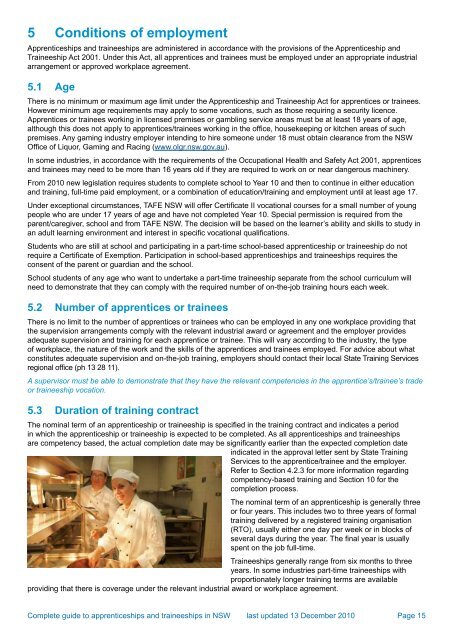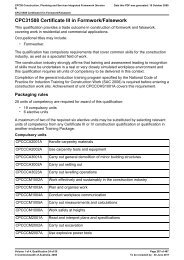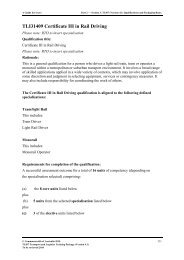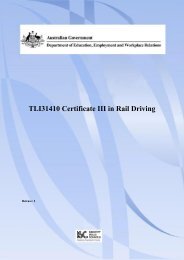A guide to apprenticeships and traineeships in NSW
A guide to apprenticeships and traineeships in NSW
A guide to apprenticeships and traineeships in NSW
You also want an ePaper? Increase the reach of your titles
YUMPU automatically turns print PDFs into web optimized ePapers that Google loves.
5 Conditions of employment<br />
Apprenticeships <strong>and</strong> <strong>tra<strong>in</strong>eeships</strong> are adm<strong>in</strong>istered <strong>in</strong> accordance with the provisions of the Apprenticeship <strong>and</strong><br />
Tra<strong>in</strong>eeship Act 2001. Under this Act, all apprentices <strong>and</strong> tra<strong>in</strong>ees must be employed under an appropriate <strong>in</strong>dustrial<br />
arrangement or approved workplace agreement.<br />
5.1 Age<br />
There is no m<strong>in</strong>imum or maximum age limit under the Apprenticeship <strong>and</strong> Tra<strong>in</strong>eeship Act for apprentices or tra<strong>in</strong>ees.<br />
However m<strong>in</strong>imum age requirements may apply <strong>to</strong> some vocations, such as those requir<strong>in</strong>g a security licence.<br />
Apprentices or tra<strong>in</strong>ees work<strong>in</strong>g <strong>in</strong> licensed premises or gambl<strong>in</strong>g service areas must be at least 18 years of age,<br />
although this does not apply <strong>to</strong> apprentices/tra<strong>in</strong>ees work<strong>in</strong>g <strong>in</strong> the office, housekeep<strong>in</strong>g or kitchen areas of such<br />
premises. Any gam<strong>in</strong>g <strong>in</strong>dustry employer <strong>in</strong>tend<strong>in</strong>g <strong>to</strong> hire someone under 18 must obta<strong>in</strong> clearance from the <strong>NSW</strong><br />
Office of Liquor, Gam<strong>in</strong>g <strong>and</strong> Rac<strong>in</strong>g (www.olgr.nsw.gov.au).<br />
In some <strong>in</strong>dustries, <strong>in</strong> accordance with the requirements of the Occupational Health <strong>and</strong> Safety Act 2001, apprentices<br />
<strong>and</strong> tra<strong>in</strong>ees may need <strong>to</strong> be more than 16 years old if they are required <strong>to</strong> work on or near dangerous mach<strong>in</strong>ery.<br />
From 2010 new legislation requires students <strong>to</strong> complete school <strong>to</strong> Year 10 <strong>and</strong> then <strong>to</strong> cont<strong>in</strong>ue <strong>in</strong> either education<br />
<strong>and</strong> tra<strong>in</strong><strong>in</strong>g, full-time paid employment, or a comb<strong>in</strong>ation of education/tra<strong>in</strong><strong>in</strong>g <strong>and</strong> employment until at least age 17.<br />
Under exceptional circumstances, TAFE <strong>NSW</strong> will offer Certificate II vocational courses for a small number of young<br />
people who are under 17 years of age <strong>and</strong> have not completed Year 10. Special permission is required from the<br />
parent/caregiver, school <strong>and</strong> from TAFE <strong>NSW</strong>. The decision will be based on the learner’s ability <strong>and</strong> skills <strong>to</strong> study <strong>in</strong><br />
an adult learn<strong>in</strong>g environment <strong>and</strong> <strong>in</strong>terest <strong>in</strong> specific vocational qualifications.<br />
Students who are still at school <strong>and</strong> participat<strong>in</strong>g <strong>in</strong> a part-time school-based apprenticeship or tra<strong>in</strong>eeship do not<br />
require a Certificate of Exemption. Participation <strong>in</strong> school-based <strong>apprenticeships</strong> <strong>and</strong> <strong>tra<strong>in</strong>eeships</strong> requires the<br />
consent of the parent or guardian <strong>and</strong> the school.<br />
School students of any age who want <strong>to</strong> undertake a part-time tra<strong>in</strong>eeship separate from the school curriculum will<br />
need <strong>to</strong> demonstrate that they can comply with the required number of on-the-job tra<strong>in</strong><strong>in</strong>g hours each week.<br />
5.2 Number of apprentices or tra<strong>in</strong>ees<br />
There is no limit <strong>to</strong> the number of apprentices or tra<strong>in</strong>ees who can be employed <strong>in</strong> any one workplace provid<strong>in</strong>g that<br />
the supervision arrangements comply with the relevant <strong>in</strong>dustrial award or agreement <strong>and</strong> the employer provides<br />
adequate supervision <strong>and</strong> tra<strong>in</strong><strong>in</strong>g for each apprentice or tra<strong>in</strong>ee. This will vary accord<strong>in</strong>g <strong>to</strong> the <strong>in</strong>dustry, the type<br />
of workplace, the nature of the work <strong>and</strong> the skills of the apprentices <strong>and</strong> tra<strong>in</strong>ees employed. For advice about what<br />
constitutes adequate supervision <strong>and</strong> on-the-job tra<strong>in</strong><strong>in</strong>g, employers should contact their local State Tra<strong>in</strong><strong>in</strong>g Services<br />
regional office (ph 13 28 11).<br />
A supervisor must be able <strong>to</strong> demonstrate that they have the relevant competencies <strong>in</strong> the apprentice’s/tra<strong>in</strong>ee’s trade<br />
or tra<strong>in</strong>eeship vocation.<br />
5.3 Duration of tra<strong>in</strong><strong>in</strong>g contract<br />
The nom<strong>in</strong>al term of an apprenticeship or tra<strong>in</strong>eeship is specified <strong>in</strong> the tra<strong>in</strong><strong>in</strong>g contract <strong>and</strong> <strong>in</strong>dicates a period<br />
<strong>in</strong> which the apprenticeship or tra<strong>in</strong>eeship is expected <strong>to</strong> be completed. As all <strong>apprenticeships</strong> <strong>and</strong> <strong>tra<strong>in</strong>eeships</strong><br />
are competency based, the actual completion date may be significantly earlier than the expected completion date<br />
<strong>in</strong>dicated <strong>in</strong> the approval letter sent by State Tra<strong>in</strong><strong>in</strong>g<br />
Services <strong>to</strong> the apprentice/tra<strong>in</strong>ee <strong>and</strong> the employer.<br />
Refer <strong>to</strong> Section 4.2.3 for more <strong>in</strong>formation regard<strong>in</strong>g<br />
competency-based tra<strong>in</strong><strong>in</strong>g <strong>and</strong> Section 10 for the<br />
completion process.<br />
The nom<strong>in</strong>al term of an apprenticeship is generally three<br />
or four years. This <strong>in</strong>cludes two <strong>to</strong> three years of formal<br />
tra<strong>in</strong><strong>in</strong>g delivered by a registered tra<strong>in</strong><strong>in</strong>g organisation<br />
(RTO), usually either one day per week or <strong>in</strong> blocks of<br />
several days dur<strong>in</strong>g the year. The f<strong>in</strong>al year is usually<br />
spent on the job full-time.<br />
Tra<strong>in</strong>eeships generally range from six months <strong>to</strong> three<br />
years. In some <strong>in</strong>dustries part-time <strong>tra<strong>in</strong>eeships</strong> with<br />
proportionately longer tra<strong>in</strong><strong>in</strong>g terms are available<br />
provid<strong>in</strong>g that there is coverage under the relevant <strong>in</strong>dustrial award or workplace agreement.<br />
Complete <strong>guide</strong> <strong>to</strong> <strong>apprenticeships</strong> <strong>and</strong> <strong>tra<strong>in</strong>eeships</strong> <strong>in</strong> <strong>NSW</strong> last updated 13 December 2010<br />
Page 15






